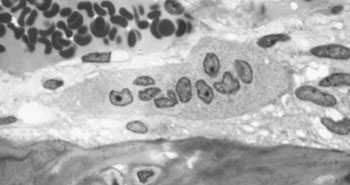A MicroRNA Regulates the Mechanism That Prevents Osteoporosis and Bone Metastasis
By LabMedica International staff writers
Posted on 07 Jul 2014
A study conducted on a mouse model of osteoporosis found that animals with higher than normal levels of the microRNA (miRNA) miR-34a were protected from the syndrome by having increased bone mass and reduced bone breakdown.Posted on 07 Jul 2014
MiRNAs are fragments of RNA about 20 nucleotides long that block gene expression by attaching to molecules of messenger RNA (mRNA) in a fashion that prevents them from transmitting the protein synthesizing instructions they had received from the DNA.

Image: Osteoclast, with bone below it, shows typical distinguishing characteristics: a large cell with multiple nuclei and a “foamy” cytosol (Photo courtesy of Wikimedia Commons).
Investigators at the University of Texas Southwestern Medical Center (Dallas, USA) have been studying how microRNAs were involved in regulating skeletal biology. To this end, they used mouse models that either underexpressed or overexpressed miR-34a.
They reported in the June 25, 2014, online edition of the journal Nature that miR-34a-overexpressing transgenic mice exhibited lower bone resorption and higher bone mass. Conversely, miR-34a knockout and heterozygous mice exhibited elevated bone resorption and reduced bone mass. At the cellular level it was found that miR-34a or molecules that mimicked the function of miR-34a blocked the development of osteoclasts (cells that cause destruction of bone), which make the bone less dense and prone to fracture. High levels of bone destruction and reduced bone density caused by excessive numbers of osteoclasts are characteristic of osteoporosis.
The investigators pointed out that the mechanisms involved in development of osteoporosis were similar to those that allow certain cancers to metastasize into bone tissue.
“This new finding may lead to the development of miR-34a mimics as a new and better treatment for osteoporosis and cancers that metastasize to the bone,” said senior author Dr. Yihong Wan, assistant professor of pharmacology at the University of Texas Southwestern Medical Center. “Interestingly, the mouse miR-34a is identical to that in humans, which means that our findings may apply to humans as well.”
Related Links:
University of Texas Southwestern Medical Center














